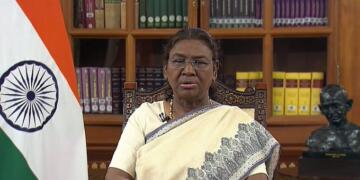The tranquil political landscape of Gujarat has been rattled by a tempest of controversy, sparked by the untimely words of Parshottam Rupala, Union Minister of Fisheries, Animal Husbandry, and Dairying. Rupala’s remarks, made at a Valmiki Samaj event, inadvertently ignited a firestorm of protest from the Kshatriya community, unearthing ancient fault lines within the socio-political fabric of Saurashtra.
Who is Parshottam Rupala?
Parshottam Rupala, a prominent figure in Gujarat’s political arena, has traversed a significant trajectory in his political career, culminating in his current role as a Union Minister. Hailing from the influential Kadva Patel community, Rupala’s ascent in politics reflects both his personal acumen and the strategic alliances he has forged within the Bharatiya Janata Party (BJP).
Rupala’s political journey commenced at the grassroots level, where he actively participated in various socio-political movements, gradually earning recognition for his leadership qualities. His steadfast commitment to the BJP’s ideology and organizational prowess propelled him into higher echelons of power, eventually leading to his appointment as a Union Minister overseeing key portfolios such as Fisheries, Animal Husbandry, and Dairying.
However, Rupala’s recent remarks at a Valmiki Samaj event have thrust him into the eye of a political storm, casting a shadow over his otherwise illustrious career. His comments, seemingly intended to resonate with the Dalit community present at the event, inadvertently ignited outrage among the Kshatriya community, particularly the erstwhile royals and their descendants.
Significance of his remarks at the Valmiki Samaj event and their unintended repercussions
At the Valmiki Samaj event, Rupala’s rhetoric took an unexpected turn when he sought to draw parallels between historical oppression and resilience among different communities. In his attempt to praise the Dalit community for their steadfastness in the face of British colonialism, Rupala inadvertently invoked the ire of the Kshatriya community by seemingly diminishing their historical role and integrity.
His remarks, while possibly intended to resonate with his audience, struck a discordant note with the Kshatriya community, who perceived them as a slight on their ancestors’ honor and legacy. The fallout from Rupala’s comments transcended mere political rhetoric, igniting a fervent response from the Kshatriya community, particularly its women, who rallied together to assert their integrity and identity in the face of perceived disparagement.
The Stirring of the Kshatriya Uprising
Rupala’s comments served as a catalyst for the emergence of a formidable Kshatriya uprising, characterized by swift and fervent mobilization across Gujarat. The perceived offense to the community’s honor galvanized Kshatriya leaders and activists, prompting them to leverage social media, poster campaigns, and public rallies to voice their discontent.
Of particular note is the resolute participation of Kshatriya women, who emerged as prominent voices in the protest movement, underscoring their unwavering commitment to upholding the dignity and honor of their community. Their impassioned response highlights the deeply ingrained sense of identity and solidarity within the Kshatriya community, transcending political affiliations to stand united against perceived affronts to their heritage.
Resonating Echoes of Historical Fault Lines
The historical animosity between the Kshatriya and Patidar communities in Saurashtra finds its roots in the political maneuvers of yesteryears, most notably embodied by the KHAM (Kshatriya, Harijan, Adivasi, and Muslim) equation devised by Madhavsinh Solanki during his tenure as Chief Minister of Gujarat in the 1980s. This strategic alliance effectively marginalized the Patidars, a dominant agricultural community, from the corridors of power, exacerbating tensions between them and the Kshatriya elite.
Past conflicts and enmities between the two communities further deepened the rift, with instances of violence and political machinations perpetuating a cycle of distrust and resentment. The Patidars, aggrieved by their exclusion from the power equation, harbored animosity towards the Kshatriya establishment, viewing them as the architects of their marginalization.
Conversely, the Kshatriyas, emboldened by their historical lineage and social status, viewed the Patidars with suspicion and apprehension, perceiving them as challengers to their traditional authority and privilege. This historical backdrop of rivalry and discord continues to cast a shadow over contemporary politics in Saurashtra, influencing electoral dynamics and shaping communal allegiances.
The BJP’s Tightrope Walk
In response to the crisis ignited by Rupala’s remarks and the ensuing Kshatriya uprising, the BJP finds itself navigating treacherous terrain, fraught with competing interests and delicate alliances. Rupala’s apology, though a gesture of contrition, failed to assuage the aggrieved Kshatriya community, underscoring the depth of their discontent and the gravity of the situation.
The BJP’s reluctance to withdraw Rupala’s candidature reflects a calculated strategy aimed at preserving its political capital and avoiding a loss of face. To concede to the demands of the Kshatriya community would risk alienating the influential Patidar demographic, whose support is crucial for the BJP’s electoral fortunes in Gujarat.
Thus, the BJP finds itself walking a tightrope, attempting to placate the aggrieved Kshatriyas while retaining the allegiance of the Patidars. This delicate balancing act underscores the party’s pragmatic approach to navigating caste dynamics and electoral imperatives, albeit at the risk of exacerbating existing fault lines and deepening communal divisions.
The Congress Conundrum
The Congress, amidst the turmoil sparked by Rupala’s remarks and the ensuing Kshatriya uprising, faces a delicate balancing act as it seeks to capitalize on the BJP’s predicament while avoiding the pitfalls of caste politics. The selection of Paresh Dhanani, a prominent Leuva Patidar leader, as its candidate for the Rajkot seat reflects the party’s strategic maneuvering to court the influential Patidar demographic without antagonizing other communities.
Unlike the BJP, which grapples with the challenge of appeasing both the Kshatriya and Patidar communities, the Congress adopts a cautious approach to caste politics, wary of reigniting historical fault lines and exacerbating communal tensions. Dhanani’s appeal to the Patidar community to refrain from reacting to the protests against Rupala underscores the party’s emphasis on coalition-building and inclusivity over divisive tactics.
By refraining from exploiting caste fault lines and focusing instead on broader issues of governance and development, the Congress seeks to present itself as a viable alternative to the BJP, appealing to a diverse cross-section of voters disillusioned by the politics of polarization and identity.
Electoral Ramifications
The controversy surrounding Rupala’s remarks and the subsequent Kshatriya protests have the potential to significantly impact the upcoming elections in Gujarat, reshaping the electoral landscape and realigning political alliances. Speculation abounds regarding the extent to which the crisis will influence voter sentiments and electoral outcomes.
While some political observers dismiss the significance of the Kshatriya protests as a localized issue with limited electoral ramifications, others contend that the mobilization of the Kshatriya community could signal broader discontent with the BJP’s governance and open avenues for opposition parties, including the Congress, to make inroads in traditional BJP strongholds.
The likelihood of the Kshatriya community aligning with the Congress remains a subject of debate, with differing perspectives on the community’s electoral calculus and strategic priorities. While some argue that the Kshatriya protests may translate into electoral gains for the Congress, others contend that the community’s historical allegiance to the BJP and pragmatic considerations of electoral arithmetic may mitigate the impact of the crisis on actual voting patterns.
In Conclusion, The confluence of Rupala’s remarks and the ensuing Kshatriya uprising has unearthed deep-seated fault lines within Gujarat’s political landscape, exposing the delicate interplay of caste dynamics and electoral strategy. As the state braces for the impending elections, the repercussions of this controversy are poised to shape the trajectory of Gujarat’s political future.
Also Read: India’s Strong Warning: “Hands off” Jammu and Kashmir, Pakistan and Turkey told





























